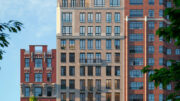A proposal has been submitted to the NYC Landmarks Preservation Commission (LPC) detailing plans for the restoration of the south aisle of Grace Church, a historic landmark at 802 Broadway in Manhattan’s Greenwich Village. Assembled by Building Conservation Associates (BCA), the proposal seeks to address deterioration issues with the structure, which in large part have been caused by water damage over a number of years.
Over time, the building’s decorative stonework has decayed, with cracks, spalling, and erosion leading to water infiltration that has damaged the building’s interior. Earlier inspections revealed loose stone elements and compromised profiles, prompting the removal of hazardous pieces during prior surveys. If approved, work will include replacing stone tracery, pinnacles, and balustrades, as well as adding roof reinforcement to prevent future water infiltration.
Project work places an emphasis on replicating the building’s historic details with modern materials. Indiana limestone will replace many of the flat ashlar units, while ornamental elements like stone tracery will be recreated using cast stone. Alongside masonry repairs, the stained glass windows will receive a new protective glazing system to prevent further water damage.
Grace Church is located at the intersection of 10th Street and Broadway, and is a short walk south of Union Square. Transit nearby the building includes subway stations served by the N, Q, R, W, L, 4, 5, and 6 trains.
Subscribe to YIMBY’s daily e-mail
Follow YIMBYgram for real-time photo updates
Like YIMBY on Facebook
Follow YIMBY’s Twitter for the latest in YIMBYnews










Marble was under serious attack when NYC was a coal-burning city. Hopefully, matters have improved in that regard. The New York Public Library replaced its decayed marble balusters with cast stone during an extensive restoration of its facade. I suppose its use here is forgivable.
Grace Church is one of our most decorative church exteriors. I often wish the interior was not so dark and gloomy. As we can see from Notre Dame, Paris, this was not the case in the Middle Ages. Perhaps 19th century people expected churches to be gloomy misunderstanding soiled interiors.
Yes, often serious is confused with gloomy.
Cast stone to replace marble? That is horrifying, and I’m not trying to be funny. The landmarks commission should be ashamed of themselves.
The library’s cast stone is on the parapet and not so noticeable. The church’s will be more apparent. Marble has a luminous quality as sunlight can penetrate it half an inch or more.